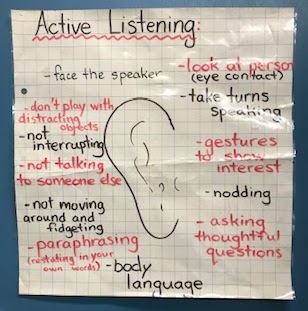Listening: The Key to 2 Way Communication
Some important facts about listening:
- the average person speaks anywhere from 125 to 175 words per minute.
- we have the ability to listen to around 300 to 450 words per minute.
- often our brain does not fully engage in listening as it can multitask and do so many other things while we can still appear like we are listening.
To demonstrate how quickly communication can breakdown play a quick game of “broken telephone”
Students sit in a circle; the teacher whispers a message (be sure to include lots of descriptive detail) to the first student and then the same message is whispered from one student to the next; the final student says the message out loud; it is often dramatically different from the original message. This game can also further demonstrate the pitfalls of “Trouble Talk“, specifically rumors and gossip. Relay that this is what happens each day when people believe things others supposedly said without hearing it first hand.
Brainstorm with students all the possible factors that may lead to poor or faulty communication.
Active Listening:
Brainstorm with students what active listening means.
What does it look like?
What does it sound like?
What does it feel like?

Active Listening is the skill of fully concentrating on what is being said rather than passively hearing the message. It involves not only concentrating on what is being said, but also understanding, responding, and remembering what has been said. It is a skill that can be learned and developed with practice.
To demonstrate the importance of active listening try this simple activity with students.
Have students draw a simple design on a piece of paper. Pair students up and without showing their drawing, have them take turns giving instructions on how to replicate the design.
Do this once where the receiver can only listen and not ask questions and then a second time where the receiver can ask questions after each instruction. Compare the designs. Switch roles.
Brainstorm with students all the possible factors that helped them best recreate the drawing.
Good communication is not only about expressing yourself but also actively listening and working to understand what the other person is saying. Learning and practicing these healthy communication skills will prepare you for the times when communication with someone is most important.
Active Listening is a skill that needs to be taught and practiced.
Introduction to Mindful Listening
This video gives great tips and an intro to breaking the ice and having a good conversation.
Some video examples of Active Listening (comedy):
Paraphrasing:
Paraphrasing is when a person reads or actively listens to a message and is able to clearly express it back in their own words (written or spoken). In a paraphrase, the original ideas or meaning are maintained, but the wording has to be your own. Like active listening, paraphrasing is a skill that needs to be taught explicitly, practiced, and developed.

